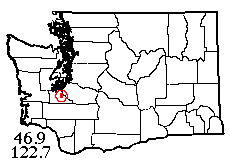
Spider Collector's Journal (5th page: 1993-4) Copyright © 2005 by Rod Crawford
As explained on the first page, most of these notes of fun (and not so fun) trips to collect spiders for research at the Burke Museum appeared in Scarabogram, newsletter of "Scarabs: The Bug Society," in their original forms. References to the editor mean me; most other persons mentioned are Scarabs members. Dates of field trips head each paragraph. Maps showing the location of sites within Washington state follow the grid system outlined in the Washington Spider Checklist. RETURN TO INDEX
 |
25 III 1993: This year's spring trips, which weren't written up in detail, began on 25 March with a visit to Weir Prairie in Thurston County [recent maps, for reasons unknown to me, call it Tenalquot Prairie but it's still Weir to me.] With helpers Song Choe and Jeremy Miller, I took 24 spider species from the west side and 36 from the east side of this typical mounded prairie, which had been invaded by Scots broom but (I understand) has had some restoration since then. The best spiders were from the east side, an oak-forest gnaphosid Orodrassus assimilis and an undescribed Lepthyphantes previously found in Alaska!
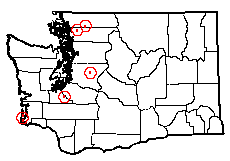 |
IV-V 1993: On April 4, Jeremy, Song and I visited a very wet Sphagnum bog near Sedro Woolley; 32 species were taken, mostly from the surrounding Spiraea marsh. On May 2, Song and I actually made it to Kings Lake Natural Area Preserve (NAP) thanks to directions from Scarab Kulzer. The abortive trip of 1991 is now but a memory! The 28 spider species taken included some very cool bog spiders; both of the endangered beetles found here were also seen. On May 16, Song, Jeremy and I visited secluded Fiander Lake in the Fort Lewis military reservation. Forest, marsh and shore habitats produced 33 species, only two of them non-native, but oddly the introduced zebra jumping spider Salticus scenicus was abundant there. A new Grammonota species was found literally floating near the lake's edge, and 7 species were under the loose bark of trees killed by a recent water level rise. On May 18, I visited the Long Beach Peninsula, Washington coast, collecting small but sufficient samples from bogs and dunes in two areas. An extremely successful trip on May 23 with Song and Jeremy visited Olivine Bridge NAP in a remote part of the north Cascade foothills. To access the area we had to show our state permit to a timber-company gatekeeper. He couldn't believe his ears when we said we were after spiders! The site is a rare mid-elevation ultramafic (serpentine) bedrock area with unusual vegetation ... and spiders! A cool 50 species were taken, of which 2 are otherwise known only from eastern Washington, and a third (a dictynid) has yet to be identified to genus. [Somewhere in here, Jerry Austin and I did the first repeat moth monitoring in the 1992 gypsy moth spray area. Throughout the area checked, moth populations (after correcting for temperature) were down 87%, one year after the spraying, from pre-spray levels. This includes sites just outside the area sprayed. See below for the 1994 moth monitoring.]
On June 17, the "Wings of Paradise" moth exhibit (most of one floor), curated by me, opened at the Burke Museum. On June 20-25 the American Arachnological Society met on campus, hosted by me. Even with friends helping, I never worked so hard in my life! It all culminated in the society's official field trip, as told in American Arachnology:
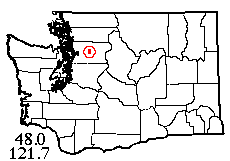 |
25 VI 1993: Arranging this field trip nearly drove me crazy. It was
the only feature of this year's meeting that didn't run smoothly. After days
of increasingly frantic arrangements for drivers, and with only 2 days to go,
my months-old arrangement for use of university vans fell through when the latest
bureaucratic regulation was unveiled: conference attendees can't ride in university
vehicles. By this time, it was too late to get the number of vans needed from
a reputable rental agency, so we had to employ an agency that shall remain nameless.
Friday morning came. The vans were duly delivered -- with essentially empty
gas tanks!
After a gas stop
we arrived at the trailhead for Lake 22, one of the most beautiful spots within
60 miles of Seattle. A not especially difficult trail (as mountain hikes go
in this region) brings one through magnificent old-growth red cedar to a spectacular
rocky lake basin which, at only 2440' elevation, has vegetation resembling treeline
habitats 3000' higher, due to late snow melt. Since many participants came from
non-mountainous regions, I expected many to collect only partway up the trail,
but in fact, most made it to the lake [and several flatlanders complained about
the climb afterwards!], shortly before noon of a beautiful day. Among the more
interesting species found were the jumping spider Sitticus lineolatus,
linyphiid Sisicottus panopeus, and an undescribed but not unknown Callioplus,
all typical of much higher elevations.
Having unexpectedly
had the energy to climb straight to the lake, yr editor (after talking to the
TV folks who came along, heavy camera and all - revenge on the media is sweet!)
decided to head around the lake to a snowfield on the far side. When almost
there, feeling tired, I left my heavy backpack behind a particular rock in a
large talus field. Big mistake! On returning, I found (surprise!) that all the
rocks looked alike, and an hour was wasted searching for the pack. Or to put
it in face-saving fashion, naturally the trip leader should be the last one
down to watch for possible stragglers or injuries. [Well-known spiderman Vince
Roth's wife Barbara had been lost in the Olympics during part of the meeting.
This time he wasn't taking any chances: he ran back up the trail looking
for me, at age 69! So a snap of the fingers to younger complainers!]
| Mima Mounds Comparative Sampling |  |
|
| Swept: Burned Area | Swept: Unburned Area | |
| 18 spiders (9 spp.) | 37 spiders (15 spp.) | |
| 1 harvestman | 1 harvestman | |
| Pitfalls: Burned Area | Pitfalls: Unburned Area | |
| 0 spiders | 2 spiders (2 spp.) | |
| 2 isopods | 1 beetle | |
7 & 18 VII 1993: A busy spring culminating in the big exhibit and
then, the following week, running the AAS meeting just about ruined yr editor.
By July, though, I was ready for 2 trips to the "prairie" areas south
of Olympia. First, on the 7th, I went with grad student Patty Char to her study
area (of butterfly populations) at the Mima Mounds. Half of the mounded prairie
here was burned last year to control Scots broom and I tried a little experiment:
equal time sweeping (1 hour each) and pitfall trapping (5 traps each for 7 hours)
in the burned and unburned areas. Results are in the table above. Every one
of the 9 spider species found in the burned area was common and widespread.
The pitfalls here yielded only the alien isopod Porcellio scaber. The
17 species from the unburned area included the first western Washington record
of the steppe species Theridion petraeum and my third record overall
of the rare, beautiful prairie wolf spider Pardosa distincta, a female
with eggs. Will these spiders survive the "management" of this site?
We'll have to wait and see.
While the pitfalls
at Mima were working, we paid a short visit to nearby Scatter Creek Wildlife
Area, where natural shortgrass prairie no longer exists (if it ever did) but
there is plenty of long-grass field-like habitat and some patches of diverse
native flora, together with some of the biggest oak trees I've seen in Washington.
Several interesting species were taken, but the big surprise was Pardosa
ramulosa, a wolf spider hitherto known from California north to southernmost
Oregon. After finding this unexpected prize in my Scatter Creek collection,
I returned there July 18th with artist friend Louise Smith. We added a number
of species for the site, but alas, no ramulosa, for which we were probably
too late.
Venturing farther
south, I thought I might re-investigate a fossil locality on the Chehalis River
I'd visited in 1976 with geologist friend Joyce. I was fully prepared to get
lost, but amazingly found the exact spot without trouble; that neighborhood
hasn't changed. This spot, on a mudstone riverbank under riparian woodland and
farmers' fields, was where I found Pardosa californica females in 1976.
From that day to this, I've found them nowhere else. I was returning this time
to get males - and succeeded! Now how do we explain the occurrence of a species
in just one spot in the state, apparently not in any way unique?
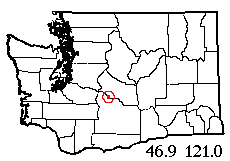 |
12 VIII 1993: Four regular spider trips in late 1993 were not written up. One, however, deserves "posthumous" notice, for it was the last field excursion with my father Clarence Crawford (then aged 82) and my uncle Greg Walton. Dad and my uncle decided they wanted to go fishing this summer, and brought me along to help since Dad could no longer walk unassisted. Given the area they'd decided on, I talked them into stopping at Cottonwood Campground on the Naches River. My ulterior motive: in 1984, Wayne Maddison (then of Harvard, later world-class jumping spider expert in Arizona) had visited this site and collected the rare, tiny jumping spider Marchena minuta under ponderosa pine bark scales - its only locality in Washington. After helping Dad set up on the riverbank, I set up some pitfall traps and started prying off loose bark scales on the pines in the campground. Later, I moved uphill across the highway to where there were more pines to "bark" and also some lusher vegetation to sample. In the end I got several Marchena specimens and a few other cool spiders, most notably the first state record of the jumping spider Phanias monticola and my second specimen ever of the hump-backed theridiid, Chrysso. I've tried the pine bark habitat elsewhere but no more Marchena. Again, how do you explain occurrence of a species at just one spot in the state? Dad and my uncle got a few fish and enjoyed the trip, which was to be their last (though Dad survived almost 11 more years with mind intact but legs useless).
 |
10 IV-22 V 1994: Jerry Austin and yr editor have now finished the third year's moth monitoring work. In the 1992 gypsy moth spray area, general populations are well above 1993's (at all but 2 sites), but there are only 2 sites where they are close to being back to the 1992 level; the others are somewhere in between. One of our new control sites, Moss Lake (Moth Lake?) proved really phenomenal, and we got 127 specimens in the first hour and 3/4 (including the hawk moth Hyles lineata) - then it started to rain! We had to repeat the site 11 days later when, with a lower temperature, we only got 72 moths. Our other new control site was Bloedel Reserve on Bainbridge Island, where the 162-moth catch (our best night) included the huge Antheraea polyphemus. Worst night was the first abortive visit to Big Soos where, due to low temperature, our catch was zero (a repeat visit in 6 days got 49). We had various adventures during this year's trips. At Big Soos, a very good moth which I was searching for behind Jerry, flew around him and landed on his pants. He was so excited at its identity that he could only say "It's a-- it's a-- it's a-- it's a--"; finally I figured out that I was supposed to come over and catch it! In Des Moines, I was scouting approaches to our site while a woman in her front yard was vainly trying to attract my attention. Finally I noticed her: "Oh, sir-- oh, sir-- could you help me please? I have a snake in my living room!" It seems the cat had carried in a garter snake (not too seriously damaged) and left it right where anyone coming into the house would have to step over it. The poor woman was petrified! Jerry walked over to find out what was going on just as I was carrying the snake out the door. His expression was priceless. On returning from the Bloedel Reserve (an excellent place for a group field trip), Jerry pulled the van keys out of his pocket to give them to me, and stuck to them was a Chinese cookie fortune: "Put the data you have uncovered to beneficial use."
[This year the Kuril Islands Project (IKIP) began to monopolize my time. Readers of this site won't find much more about collecting in Washington until 1998. An account of the 1994 Kuril Expedition is on a separate page, as are accounts of the 1996 and 1997 expeditions.]
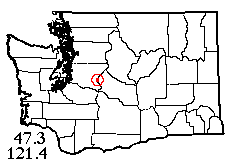 |
26 XII 1994: Over the holidays, yr editor and his friend Joyce went hunting "snow bugs" with new Scarab Ed Lisowski. Ed is interested in a wingless scorpionfly (Mecoptera) called Boreus and a wingless crane fly called Chionea, both of which are winter active and may be found on the snow surface, chiefly in the mountains. Chionea are believed to live mainly under the snow, but to come onto the snow surface for mating. We went one afternoon to the Asahel Curtis Nature Trail on Humpback Creek, just this side of Snoqualmie Pass, and before sunset found little on the snow except springtails. But after dark, with the temperature about 1° below freezing, we started to see them among the alder trunks! By 8:30 PM, we had 13 specimens of two Chionea species. They are weird-looking critters! I was hoping to find some grylloblattids, but no such luck...
This page last updated 21 March, 2025